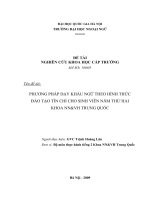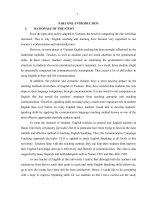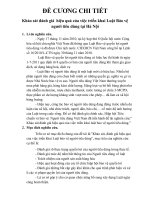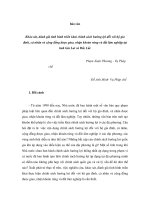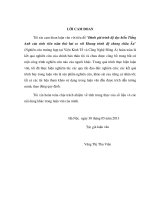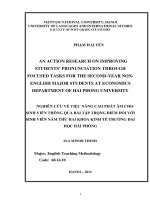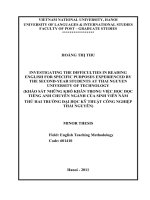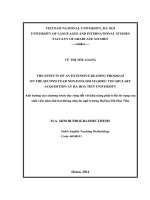Thái độ của sinh viên đối với việc học giáo trình Functioning in Business bằng phần mềm DynED Một khảo sát đánh giá đối với sinh viên năm thứ hai của trường Đạ
Bạn đang xem bản rút gọn của tài liệu. Xem và tải ngay bản đầy đủ của tài liệu tại đây (1.43 MB, 61 trang )
i
VIETNAM NATIONAL UNIVERSITY, HA NOI
THE UNIVERSITY OF LANGUAGES AND INTERNATIONAL STUDIES
THE FACULTY OF POST GRADUATE- STUDIES
**********************************************
NGUYỄN THỊ NHƯ QUỲNH
TM TĂT LUN VĂN
LEARNERS’ ATTITUDE TOWARDS LEARNING THE
COURSEWARE “FUNCTIONING IN BUSINESS”
THROUGH DYNED SOFTWARE:
A SURVEY EVALUATION BY THE SECOND YEAR NON-
ENGLISH MAJOR STUDENTS AT HANOI UNIVERSITY OF
BUSINESS AND TECHNOLOGY
(Thái độ của sinh viên đối với việc học giáo trình “Functioning in Business”
bằng phần mềm DynED: Một khảo sát đánh giá đối với sinh viên năm thứ hai
của trường Đại Học Kinh Doanh và Công Nghệ Hà Nội)
M.A.MINOR PROGRAM THESIS
FIELD : METHODOLOGY
CODE : 601410
HANOI, 2011
ii
VIETNAM NATIONAL UNIVERSITY
THE UNIVERSITY OF LANGUAGES AND INTERNATIONAL STUDIES
FACUTY OF POST GRADUATE- STUDIES
****************************************
NGUYỄN THỊ NHƯ QUỲNH
LEARNERS’ ATTITUDE TOWARDS LEARNING THE
COURSEWARE “FUNCTIONING IN BUSINESS”
THROUGH DYNED SOFTWARE:
A SURVEY EVALUATION BY THE SECOND YEAR NON-
ENGLISH MAJOR STUDENTS AT HANOI UNIVERSITY OF
BUSINESS AND TECHNOLOGY
(Thái độ của sinh viên đối với việc học giáo trình “Functioning in Business”
bằng phần mềm DynED: Một khảo sát đánh giá đối với sinh viên năm thứ hai
của trường Đại Học Kinh Doanh và Công Nghệ Hà Nội)
M.A. MINOR PROGRAM THESIS
FIELD : METHODOLOGY
CODE : 601410
SUPERVISOR: NGUYỄN BÀNG, M.A
HANOI, 2011
vi
TABLE OF CONTENTS
Page
PART I: INTRODUCTION 1
1. Rationale of the thesis 1
2. Aims of the thesis 1
3. Significance of the thesis 2
4. Scope of the thesis 2
5 Design of the thesis 3
PART 2: DEVELOPMENT 4
Chapter 1: Literature Review 4
1.1. Courseware in Language Teaching and Learning 4
1.1.1.Definition of Courseware 5
1.1.2.Reasons for Courseware Evaluation 6
1.1.3.Role of Teaching Courseware in General English 6
1.1.4.Types of Courseware Evaluation 7
1.2. Courseware Evaluation Framework 10
1.2.1. Presentation and Organization of the Content 12
1.2.2. Evaluation of Learning 16
1.3. Dynamic Education 17
1.3.1.Introduction of Dynamic Program 17
1.3.2.Pegagogical Framework of DynED 17
1.3.3.“Functioning in Business” Courseware of DynED Program 21
1.3.4.The Role of DynED as CALL 23
1.3.5.Related Studies 23
1.4. Summary 23
Chapter 2: Research Methodology 25
2.1. An overview of current English Teaching and Learning at HUBT 25
2.2. Research Methods 26
2.2.1. Research Questions 26
vii
2.2.2. Research Design 26
2.2.3. Research Instrument 26
2.2.4. Participants 27
2.2.5. Data collection procedures 27
2.3. Summary 27
Chapter 3: Data Analysis and Discussion 28
3.1. Results of the Content in “Functioning in Business” Courseware 28
3.2. Results of the Interactivity in “Functioning in Business” Courseware 30
3.3. Results of the Navigation in “Functioning in Business” Courseware 31
3.4. Results of the Feedback in “Functioning in Business” Courseware 32
3.5. Results of the Screen Design in “Functioning in Business” Courseware 33
3.6. Results of the Students’ Learning to“ the Courseware 35
3.7. Results of the Students’ Preference to the Courseware 38
3.8. Recommendations for material improvements 39
3.9. Summary of major findings 41
PART 3: CONCLUSION 43
3.1. Conclusions 43
3.2. Implications 44
3.3. Limitations 45
3.4. Suggestions for further study 46
REFERENCES I
APPENDIX V
viii
LIST OF ABBREVIATIONS
HUBT : Hanoi University of Business and Technology
CALL : Computer-Assisted language learning
ICT : The advent of Information and Communication Technology
CAI : Computer-Assisted Instruction
CAL : Computer Assisted learning
HC : Hypermedia courseware
DynED : Dynamic Education
LIOJ : Institute of Japan
ix
LIST OF FIGURES AND TABLES
Figures
Figure 1: Diagram of the Evaluation Framework
Figure 2: Video Interaction in DynED
Figure 3: Sample of Vocabulary question in DynED
Figure 4: Sample of sentence construction in DynED
Figure 5: Record Manager in DynED
Tables
Table 1: Analysis on the Content in the “Functioning in Business” Courseware
Table 2: Analysis on the Interactivity of the “Functioning in Business” Courseware
Table 3: Analysis on the Navigation of the IMM Courseware
Table 4: The analysis of the feedback of the “Functioning in Business” courseware
Table 5: Analysis on the Screen Design of the Courseware
Table 6: The analysis on the students’ learning towards the courseware
Table 7: Analysis on Students’ Preferences towards the Use of “Functioning in
Business” Courseware Compared to Traditional Methods of Learning.
1
PART I: INTRODUCTION
1. Rationale of the thesis
In the past, English lessons were normally taught through conventional classroom
instruction, in which, most often than not, the teacher would be teaching in front of the
classroom, while students were passive recipients of knowledge. However, presently
technology has had a great influence on the educational practices in the classrooms in
which computer-based technology is very much in use to enhance instruction and transfer
the focus from the teacher to the students in the learning process (Bork, 2001; Ertmer,
Gopalakrishnan & Ross, 2001).
Incorporating technology in the classroom is beneficial to the students in a number of
ways: assisting students‟ understanding of concepts, enhancing students‟ motivation in
exploring, investigating, conjecturing, creating and discovering principles, and making
generalization and connections (Wertherimer, 1990); engaging students involvement in the
learning process (Guha, 2003) and motivating them.
The advent of Information and Communication Technology (ICT) has brought the concept
of Computer-Assisted Instruction (CAI) into the classroom. CAI is a kind of instruction
that exploits computer software to assist teachers to teach information or skills related to a
particular topic (Roblyer, 2004), and students can interact directly with lessons
programmed into the computer system (Smaldino, Russell, Heinich & Molenda, 2005).
There are many types of software that teachers can use to develop their own teaching
courseware.
Studies demonstrate that the DynED software can be used to help improve students‟
achievement in English hence, to eradicate much English anxiety and fear of using
computer software and learning English.
2. Aims of the thesis
The purpose of this study is to evaluate a courseware for the Business Communications
course. The courseware is specifically known as “Functioning in Business”. It consists of
2
additional information on the subject and quizzes to complement the Business
Communications course. The objective is the evaluation of the courseware by the students
and that of the researcher on its strengths and weaknesses of the courseware. The study is
conducted primarily to find out the attitude of students towards the use of the Business
Communications courseware as a supplementary teaching/learning material in HUBT.
3. Significance of the thesis
Many teachers often face problems and difficulties in teaching English namely due to
shortage of instructional media, students‟ lack of understanding of the basic concepts of
English, students‟ incomplete work and negative learning attitude. Researchers have shown
that students also tend to „find school much less interesting than the myriad of devices they
carry in their pocket and backpacks‟ (Prensky, 2005). Thus, teachers need to find
interesting strategies and tools to make teaching and learning more effective and
interesting to the students.
Practically, the findings of the thesis will be of great use not only to the researcher but also
to the teachers who are teaching DynED software to students at HUBT. Furthermore, the
findings of the thesis will form a foundation toward improving the quality of the
courseware which is currently in use for the students at HUBT.
4. Scope of the thesis
In courseware evaluation, there has been a great number of criteria that should be taken
into consideration such as: the content, the organization and presentation, the design
factors, the pedagogical parameter, and so on. In this study, the researcher focuses on the
following criteria: content, interactivity, screen design, navigation, feedback, students‟
learning and preference towards the courseware. Due to the limited scope of a minor thesis,
research subjects are primarily confined to English students who have been learning the
courseware for 1 year. However, to ensure the validity and reliability of the given
information, teachers‟ views, which are collected in an informal way through their
observation and experience in working/talking with students, is also taken into account.
3
5. Design of the thesis
There are three main parts in this thesis: introduction, development, and conclusion.
The introduction provides the rationale, the aims, the significance, the scope, and design of
the thesis.
The development consists of three chapters:
Chapter one presents a review of literature concentrating on the issues related to
courseware evaluation. It discusses the definition of courseware, the roles and types of
courseware evaluation in language teaching and learning, and presents major issues in
courseware evaluation including purposes for courseware evaluation, types of courseware
evaluation, and courseware evaluation framework.
Chapter two focuses on the methodology employed in this thesis including an overview of
current English teaching and learning at HUBT, research methodology, and the data
collection procedures.
Chapter three discusses the findings of the study; points out the strengths, weaknesses of
the courseware, and suggests the recommendations for the courseware improvement.
The conclusion provides a brief summary of all the major parts being present in the study,
the conclusions drawn out and suggestions for further research.
4
PART 2: DEVELOPMENT
Chapter 1: Literature Review
1.1. Courseware in Language Teaching and Learning
As technology improves, computers are becoming more and more common, and in an
increasingly diverse number of applications. Moreover, not only have computers become
commonplace, they have also become indispensable. Without the computer, for example,
many recent scientific researches would not have been possible. Furthermore, the
demanding on high-speed communication and the immediate accessibility to information
in different ways has fostered the advance for the development of computer technology.
“These demands and technological advances have worked hand in hand to propel the art
and science of multimedia to a new level, resulting in products that weave together text,
graphics, animation, audio and video.” (Norton Peter, 2001: 419). Therefore, computer is
considered as a tool to improve the quality of teaching technology. Recently, the process of
teaching with assistance of computer is known as Computer-Assisted Instruction (CAI).
The philosophy of CAI is that the lessons allow the learners to learn their own using
structured and/or unstructured interactive lessons.
The use of computer as a teaching media provides several advantages, as stated by Sudjana
& Rival (2009:137). They are:
i) The role of computer will stimulate students’ motivation in learning process
ii) Color, sound, and graphic increase the students’ impression of realism
iii) Students’ individual responses in learning activities will produce long term
memory.
They also add that computer as teaching media provides audio and visualization which
helps students to recognize, enrich, and clarify the concept of the learning materials they
are learning.
In line with them, Mc. Donough, et al (1994:211) stated that there are several advantages
by using computer as learning media, such as:
5
i) Computer gives stimulus to the students’ learning process
ii) Computer provides audio and visual effect which can catch students’ interest and
attention
iii) Computer helps to recall and rebuild the concept of previous material
iv) Computer activates students’ responses
v) Computer triggers interactive learning process, and computer also provides
learning sources which are easy to be modified.
However, besides those advantages, Sudjana & Rival (2009:138) also explain several
constraints of the use of computer as learning media as follows:
- The program, especially for teaching goal, is still less developed if it is
compared with other goal.
- The digital software used is usually not flexible to be used in every computer by
comparing with the benefit itself.
- Because the role of human user is still strongly demanded, the teacher should
have high-technology skill, at least to operate the system and program of the
computer itself.
1.1.1. Definition of courseware
The term „courseware‟ was introduced by “SCORE! Educational Centers”, the pioneering
developer that coined the term by combining the words 'course' and 'software'. It was
originally used to term any computerized packages of teaching-learning material that
instructors could supplement to the main lessons. Criswell (1989) distinguishes between
two different definitions of the term, asserting that, in a narrow sense, courseware refers to
programs that administer instructions, and in a wider sense, in addition to such programs, it
relates to all handbooks, performance aids and course materials. A courseware is regarded
in a wider sense as “any educational package including a number of lessons or courses
appended with tests, teacher's/ learner's manuals and guidelines available online and/or
on CDs and/or DVDs” (Mukundan & Nimehchisalem, 2008: 72).
6
According to Gueulette‟s view, an educator refers courseware as “the actual instruction
involving both content and technique need in a CAI system; not to be confused with the
software, the actual program that directs a computer’s operation.”(1982). Thus, there are
many ways to define a courseware because the objective and applicability can vary from
one situation to another.
1.1.2 Reasons for courseware evaluation
According to Haugland (1992), the type of courseware that brings impacts to students‟
computer experiences and even seems to determine whether they have developmental
gains from these experiences. Therefore, the courseware like any other resources must
have a developmental approach to teaching and learning.
It is very important to know whether the suitability of a particular courseware could meet
the students‟ needs, its contribution to the students‟ performance and achievement, and it
could act as a motivation tool.
1.1.3 Roles of Teaching Courseware in General English Courses
Computer-Assisted Language Learning (CALL) originates from Computer – Assisted
Instruction (CAI). CALL means using computers to support language teaching and
learning in some ways (Egbert, (2009)). The current philosophy of CALL puts a strong
emphasis on students-centered material that allows learners to work on their own.
Therefore, CALL is purposed to facilitate language learning by using technology of
computer. More specifically, Levy (1997) states that CALL is digital software tool which
is designed to develop language learning and it also covers the application of the computer
in language teaching and learning. Moreover, Ihsanudin (2009:8) in his research states that
“CALL is not focused on technology but on language learning. The word assisted indicates
that technology only facilitates the language learning process. A more accurate term for
using technology in language learning might be language learning through technology
reflecting the true position of language in such activity”.
Soe (1998) says that there are three main roles of CALL in interacting with students:
7
Drill and Practice.
Computer provides practice to strengthen the learning material, and gives feedback directly
from the students‟ scores. In this case, CALL plays a role as complement media in
teaching-learning language process in classroom. Moreover, this is very useful when
teacher cannot interact with students individually.
Tutorial
Computer provides some information; moreover explains some addition concept to
students through practicing. In this case, CALL plays a role as material providers which
have been adjusted to each student‟s proficiency individually.
Dialogue
In this case, students are more active in interacting with the computer. Computer provides
learning material, practice, and some feedback. CALL in this role has been trusted as
replacement enclosed traditional method which provides more effective.
1.1. 4. Types of Courseware Evaluation
When considering possible approaches to educational evaluation, there are four general
types that are described in the literature. Evaluation of language teaching materials/CAL
(computer assisted learning) is in fact intimately linked with the authoring and
dissemination process. Thus approaches to evaluation reflect either what the authoring
process seems to be before evaluation is considered, or else what the evaluators think it
ought to be in order to make evaluation useful. Another way of putting this is that
evaluation can be designed for different purposes or roles:
Formative evaluation: to help improve the design of the CAL.
Summative evaluation: to help users choose which piece of CAL to use and for
what.
Illuminative evaluation: to uncover the important factors latent in a particular
situation of use.
Integrative evaluation: to help users make the most of a given piece of CAL.
8
Summative evaluation
The default "common-sense" view that tends to occur spontaneously to many people is that
evaluation of CAL is rather like consumer reports on goods: the manufacturer designs and
supplies them, then someone else does tests and produces reports to help purchasers decide
which to buy. This view of evaluation is linked to a view that CAL is produced like
textbooks and other goods, and that evaluation is not expected to have any direct effect on
the CAL itself by telling the authors how to improve it. Nor is it expected to help
consumers in how to use the product: only which to buy. Thus this is a common view for
perhaps these reasons: it fits the fact that a lot of CAL is produced like a lot of textbooks
by a very small team of authors with no spare resources for testing; it fits with a tradition in
the literature for comparative experimental testing (which can compare two sets of
teaching materials well); it fits the needs of new CAL users to decide what to buy; and
more broadly it is analogous to consumer reports and how we encounter most of the things
we buy, which we are offered without being consulted about how we would like them
designed.
Formative evaluation
One important use of evaluation is while it is being developed to test on learners, there are
still resources for modifying it. This is the simplest way for evaluation to help developers
to try out the CAL material on users, preferably as similar as possible to the students it is
intended for, and use an open-ended method to report the problems that arise and perhaps
also to suggest amendments. Although often the time necessary for this is not allowed for
development plans, once a developer has experience of it, it is usually clear how useful this
is. After all, testing is part of all engineering, and feedback from students is also used by
almost all lecturers to adjust their lectures and handouts. The key point to realise when
using it for CAL, is that such testing must be done in time to allow changes to the material
in the light of the results before the end of the development period. This kind of testing is
called formative evaluation, as it is used to modify ("form") the material.
The most realistic, and so most helpful, formative evaluation would use real students in
their normal learning situation. This is likely to increase the time for the whole cycle of
9
production, testing, and modification. Feedback to developers from sites who are early
users of the material is a helpful substitute that gets round this constraint. Although this
practice really means that users are running poorly tested software, and in effect doing the
testing that producers should have done themselves, it is better than having no way of
catching problems and improving the software. It, in fact, corresponds to common
processes in commercial software production, where producers keep track of users and
collect performance reports in order to improve later releases of their software.
More information on planning this kind of evaluation can be found in Alessi & Trollip
(1991), and in McAteer & Shaw (1994). As noted above, the key constraint is planning to
do the testing early enough that changes can be made. The reward is a significant
improvement in quality of the end product. Thus the main added result will not be a report,
but the modifications to the design actually done.
Illuminative evaluation
"Illuminative evaluation" refers to what might now be called loosely, and perhaps
incorrectly, ethnography. The basic idea is for the investigator to hang out with the
participants (students, teachers, etc.) to pick up how they think and feel about the situation,
and what the important underlying issues are. Its importance is as an open-ended method
that can detect what the important issues are, without which other methods often ask the
wrong questions and measure the wrong things. For instance most studies still fail to
measure motivation in any way, yet much CAL would never be used if it were not made
compulsory by teachers or experimenters. However this is not a universal truth: in some
cases students have a strong desire to use the CAL independent of coercion, in others they
are indifferent and use it only under compulsion but without disliking it, in yet others they
continue to express strong revulsion (even though educational tests show educational
benefits). Illuminative evaluation is in effect a systematic focus on discovering the
unexpected, using approaches inspired by anthropology rather than psychology.
10
Integrative evaluation
The evaluation has done many classroom studies of CAL. The kind of the study is of the
real use of CAL as part of university courses, but with evaluators who can gather more and
fuller information than a teacher alone can do through student verbal questions and
standard course feedback questionnaires. They began to argue that these evaluations served
a rather different purpose than was first envisaged. They argue that for many teachers in
practice, the question is no longer whether to use CAL or which package to use: this has
often been decided already. Instead, for them the question is how to make the best use of
CAL material they are already committed to using. Classroom evaluations typically give
much information that can be used for this. For instance if all students complain about
some issue, or score badly on a quiz item corresponding to an issue, then teachers
immediately respond to the evaluation report by adjusting in some way e.g. making an
extra announcement, or producing a supplementary handout. Thus a major use of
classroom evaluations in practice is to be formative, not of the CAL itself, but of the
overall teaching and learning situation. This of course can be and is responsive to local
variations in how the CAL is used, and for whom. It can be a significant help in integrating
CAL material into varying local situations and courses.
1.2. Courseware Evaluation Framework
The efficiency of a courseware depends on many issues. In order to build up the evaluation
instrument the authors attempted to integrate in a framework a number of important issues
emerged from researches on instructional design and system evaluation the past fifteen
years, and which should be considered from evaluators of hypermedia courseware
(H.C.)(Georgiadou & Economides, 2000). It has to be acknowledged that this framework is
relatively limited as there are numerous articles in the literature on instructional design and
system evaluation. However, the authors, in order to develop the framework, tried to
review a large number of them and then to focus on the most often cited authors and
articles. Moreover, the framework is not rigid and therefore new parts could be added or
existing ones could be altered as research advances in the area of educational hypermedia.
11
This framework is concerned with both social and practical acceptability of hypermedia
courseware, based on Nielsen‟s idea that “the overall acceptability of a computer system is
a combination of its social and practical acceptability”. The term social acceptability is
related with the social basis of an educational system. In cases when the basis is teacher-
centred, then the software that provides high levels of learner control and undermines the
teacher‟s authority is possibly socially unacceptable. On the other hand, when the basis is
student-centred, then a courseware that limits the student‟s potential for independent
discovery is socially unacceptable. Although computer-based education may not be able to
adapt to every cultural norm, they should be designed to be as culturally sensitive as
possible (Powell, 1993).
Given that a piece of hypermedia courseware is socially acceptable, its practical
acceptability is examined through the evaluation of the following four sectors:
i) Content
ii) Presentation and organization of the content
iii) Technical support and update processes and finally
iv) Evaluation of learning.
All sectors are equally important, as hypermedia courseware has to be simultaneously
pedagogically and technically sound. Moreover, each sector includes a number of criteria
that are incorporated in the evaluation instrument, which should be met in a satisfactory
level, in order to characterize a piece of hypermedia courseware of high quality.
Furthermore, cost-effectiveness should always be examined when similar products seem to
have the same educational value. Figure 1 presents in a diagram the sectors included in the
framework and the factors that are associated with them.
12
Figure 1. Diagram of the Evaluation Framework
Before presenting the evaluation instrument it is necessary to discuss the underlying theory
of the criteria used for the „presentation and organization of the content‟ and the
„evaluation of learning‟ sectors.
1.2.1 Presentation and Organization of the Content
The factors associated with this sector are the pedagogical ones that are concerned with
learning and instructional design theories and the interface design factor.
i) Pedagogical Factor: This is a complicated factor as there are different beliefs of how
humans learn. However, cognitive theories stress that learning is an active, constructive,
cumulative, self-regulated process in which the learner plays a critical role. Moreover,
current instructional theory focusing on learner-centred approaches depends on
information access and learning environments that encourage free interaction with
information. The agreement with the principles of an instructional design theory depends
13
heavily on the subject matter. In addition, teachers‟ belief is of great importance, especially
in cases when the hypermedia courseware is part of the curriculum.
Nevertheless, the two core elements that are important in all educational settings are
„motivation‟ and „structure‟, which largely define the instructional nature of an information
environment. A typical way to motivate the learner is to inform him/her what she/he will
achieve at the end of the instruction by stating the aims and objectives (Gagné, Briggs,
Wager, 1988). As far as the structure of the hypermedia courseware is concerned, that is
how to organise instructional information, this again depends on the subject matter.
However, in cases when the instructor wants to permit the learners to advance, review, see
examples, repeat the unit, or escape to explore another unit, Jonassen (1992) suggested the
network type or structured hypermedia as most appropriate. Structured hypermedia
consists of sets of nodes, each set accessible from any other set. The node sets can be
structured in any number of ways, such as node-link, hierarchical, network, depending on
the nature of the processing the designer wants to elicit from the user. The structure of
each node set with the various options available within each set needs to be conveyed on
every screen. Another method for structuring the node sets is to combine related concepts,
tie them together in an introductory block, and then permit access within the set only to
concepts contained within the set.
In hypermedia learning systems, another important element is „learner's control‟, which is
primary in the design of interactive learning as it allows students to tailor the learning
experience to their own individual needs. However, there are dangers in surrendering too
much control to the user, as low-ability students may get confused when control depends
on a wide range of options (Gray, 1989; Litchfield, 1993). The high level of learner control
may result in disorientation and distraction. The amount and type of learner control
depends on the learner characteristics (age and cognitive capabilities), content, and the
nature of the learning task (Poncelet & Proctor, 1993). Content that must be mastered and
unfamiliar tasks often requires more program control, compared to content with no
qualified mastery levels or familiar learning tasks. Learner control is more appropriate than
program control when learners are more capable and are familiar with the learning task.
Moreover, advice is provided to assist learners in making decisions and control is used
14
consistently within a lesson (Ross & Morrison, 1989). In general, the more control is given
to the learners, the more feedback about their decisions should be given (Mcateer & Shaw,
1995).
Moreover, the issues of „accommodation of individual differences‟, and „cooperative
learning‟ are highly important in the effectiveness of hypermedia-based learning. In most
education contexts learners are not homogeneous in terms of prerequisite knowledge,
motivation, experience, learning styles and cognitive styles. Also evidence suggests that
when hypermedia-learning systems are structured to allow cooperation, learners benefit
both instructionally and socially.
ii) Interface Design Factor: Interactivity - Navigation - Feedback:
Interactivity in instruction comprises the nature of the activity performed by the technology
and the learner, as well as the ability of the technology to adapt the events of instruction in
order to make that interaction more meaningful (Reigeluth, 1987). It is important to design
as much meaningful interactivity as possible into instructional software (Orr, Golas, &
Yao, 1994). The amount of navigational assistance needed is a function of the size of the
knowledge base; the usefulness of navigational aids that are already part of the authoring
software, and the types of links the software allows (Locatis, Letourneau & Banvard,
1989). Guidelines for increased interactivity were produced from researchers
(Shneiderman & Kearsley, 1989; Tessmer, Jonassen & Caverly, 1989) and are used in the
instrument as evaluation items in the relevant section.
The basic factors that can determine the effectiveness of feedback are the type and
frequency of feedback given and the delay between feedback and instruction (Jonassen &
Hannum, 1987). Feedback is closely related with the issue of interaction, as action without
feedback is completely unproductive for a learner. Laurillard (1993) identifies two types of
feedback, „intrinsic‟ and „extrinsic‟. Intrinsic feedback is what given as a natural
consequence of an action. To illustrate the concept of intrinsic feedback Laurillard uses
examples of a child's actions while playing with water as the physical world responds to
the child's actions of filling, pouring, etc. On the other hand extrinsic feedback does not
occur within a situation but as an external comment on it: right or wrong. She suggests that
15
extrinsic feedback is not a necessary consequence of the action, and therefore is not
expressed in the world of the action itself, but at the level of the description of the action.
In computer-based instruction, however, the intrinsic feedback relates to navigation and
interactivity with the instructional program, and the extrinsic feedback relates to the
feedback on user's performance. Schimmel (1988) identifies three types of extrinsic
feedback:
a) Confirmation feedback that simply confirms whether a learner's answer is correct
or incorrect
b) Correct response feedback that presents the correct answer
c) Explanatory feedback, such as a step-by-step solution to an incorrectly answered
question.
Many actions require more extended extrinsic feedback than confirmation feedback.
Simple answers such as right or wrong cannot provide any information about how learners
should correct their performance. A more helpful form of extrinsic feedback would give
the learner information about how to adapt and correct their performance, such as correct
response and explanation feedback.
iii) „Screen design‟ is also an important evaluation factor. Different screen elements should
be used to present stimulating information that will motivate and assist the learners in
retaining and recalling the information. The psychological limitations to consider when
designing hypermedia learning systems include:
a) Memory load: i.e. how many different control icons is it reasonable for learners to
remember at any one time?
b) Perception: i.e. what colours and fonts provide the best readability?,
c) Attention: i.e. how can the users' attention be drawn to information that is relevant,
when there is a lot of different information on the screen?
A large number of screen design guidelines produced from several researchers on
educational technology exist in the literature and the relevant items on the evaluation
16
instrument are based on these (Morris, Owen & Fraser, 1994; Cox & Walker, 1993;
Clarke, 1992; Mcateer & Shaw, 1995).
1.2.2 Evaluation of Learning
Marchionini (1990) argued that the interactivity of hypermedia systems provides learners
with access to vast amount of information in varied forms, control over the process of
learning, and the potential for collaboration with the system and other people. Such
empowerment of learners forces evaluators of learning to adopt a broad-based set of
methods and criteria to accommodate 'self-directed' learning. He proposes a 'multi-faceted'
approach to the evaluation of hypermedia based learning that addresses both the outcomes
and the processes of learning.
The learning outcomes are evaluated through performance tests typically used to judge the
quality and the quantity of learning, which usually have the form of „pre-tests‟ used to
determine learning outcomes prior to the intervention and „immediate‟ and „delayed post-
tests‟ to examine learning outcomes after the intervention. The learning process refers to
the usability of a product and should be evaluated by observing and measuring the end-
users attitudes. Usability is usually associated with five parameters (Nielsen, 1990):
a) Easy to learn: Users can quickly get some work done with the system
b) Efficient to use: Once the user has learnt the system, a high level of productivity is
possible
c) Easy to remember: The casual user is able to return to using the system after some
period without having to learn everything all over
d) Few errors: Users do not make many errors during the use of the system or if they
do so they can easily recover them
e) Pleasant to use: Users are subjectively satisfied by using the system.
17
1.3 Dynamic Education (DynED)
1.3.1 Introduction of Dynamic Education Program
Dynamic Education or DynED was founded in 1987 by the former director of the
Language Institute of Japan (LIOJ), Lance Knowles, and a team of engineers. DynED
created the world‟s first interactive multimedia language learning in 1988 and received a
U.S. patent for this invention in 1991. DynED focused on combining the multimedia
technology and classroom activities. Moreover, DynED mission is to help students develop
the English skills they need to succeed in school and career.
Overall, it can be concluded that DynED is multimedia language software and services
which may be used by schools, universities and business worldwide.
1.3.2 Pedagogical Framework of DynED
Fundamentally, DynED courses are based on research based approaches to language
learning and curriculum design, extensive classroom experience, and advanced human
interface design. The effectiveness of its courses is based on over twenty-five years of
experience in programs from around the world and on recent findings in the neurosciences.
In addition, DynED has access to and actively utilizes the real-time study records of
thousands of students from around the world.
What makes DynED different is its unique approach to the design and use of technology in
a blend with teacher-led classroom activities. To make the learning process effective,
DynED also provides feedback from placement Test, Courseware updates, Mastery Test,
and Record Manager.
DynED Placement Test
In classroom learning situation, the initial skills of students must be various. Students
should learn based on their level of proficiency, moreover they cannot be equated. Because
of this, DynED program provides placement test to enable to students learn based on their
level of proficiency.
18
DynED Courseware
In this study, the courseware selected is Functioning in Business which is suitable for
elementary to advance level in DynED program. Functioning in Business features several
types of lessons, each of which keeps learners engaged with the language in different ways,
promoting long-term learning. This courseware supports students develop their
pronunciation and oral fluency, listening and reading comprehension, sentence structure
and effective sequencing of ideas, oral presentation and summarization skills, and ability to
express abstract ideas and relationships.
The pronunciation and oral fluency are combined with speech Recognition exercises; the
Video Interactions review key concept and grammar, and introduce useful situation
language. For instance, there is a situation which students must have conversation in
telephone with the computer as shown below:
Figure 2: Video Interaction in DynED
Here, students not only practise speaking but also listening. As listening and speaking
fluency develop, the students can then focus on text, both reading and writing. It is
interesting to note that in comparison with listening and speaking, reading and writing
processors are relatively slow. Listening and speaking fluency can support the learning of
19
reading and writing skills, but reading fluency can slow down and interfere with the
development of listening skills (Knowles, 2004).
DynED Mastery Test
DynED Mastery Test is computer-assisted achievement test designed to evaluate students‟
progress and confirm mastery of the language skills developed in the course. Test items are
randomly selected from a database of test items to ensure variation for each learner and
from one test session to another. There are several types of questions in each Mastery Test,
ranging from multiple-choice, listening comprehension questions, to sentence construction
items which require click and drag manipulation. Lexical/ Grammar Question, this
multiple choice type of question generally focuses on vocabulary or grammar points, such
as which form of a verb to use. The sample of grammatical question in DynED program is
as follows:
Figure 3: Sample of Vocabulary question in DynED
A second type of question focuses on listening comprehension. For example, the students
may hear a question or statement and have to answer or complete it with the correct choice.
In the third type of test item, students are asked to move a set of words into the correct
